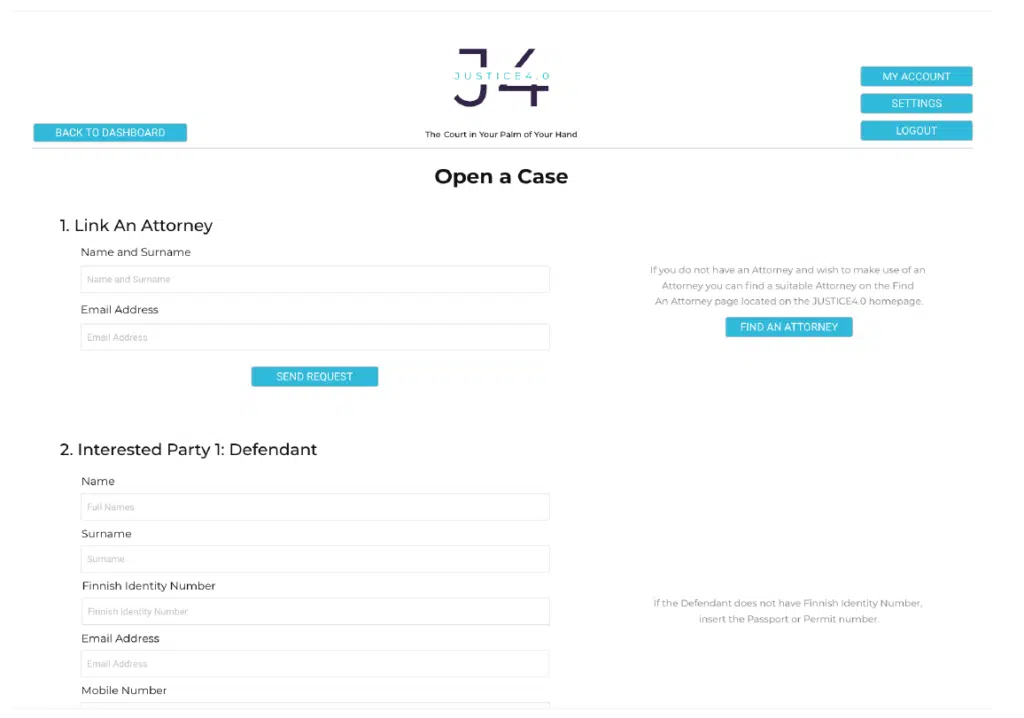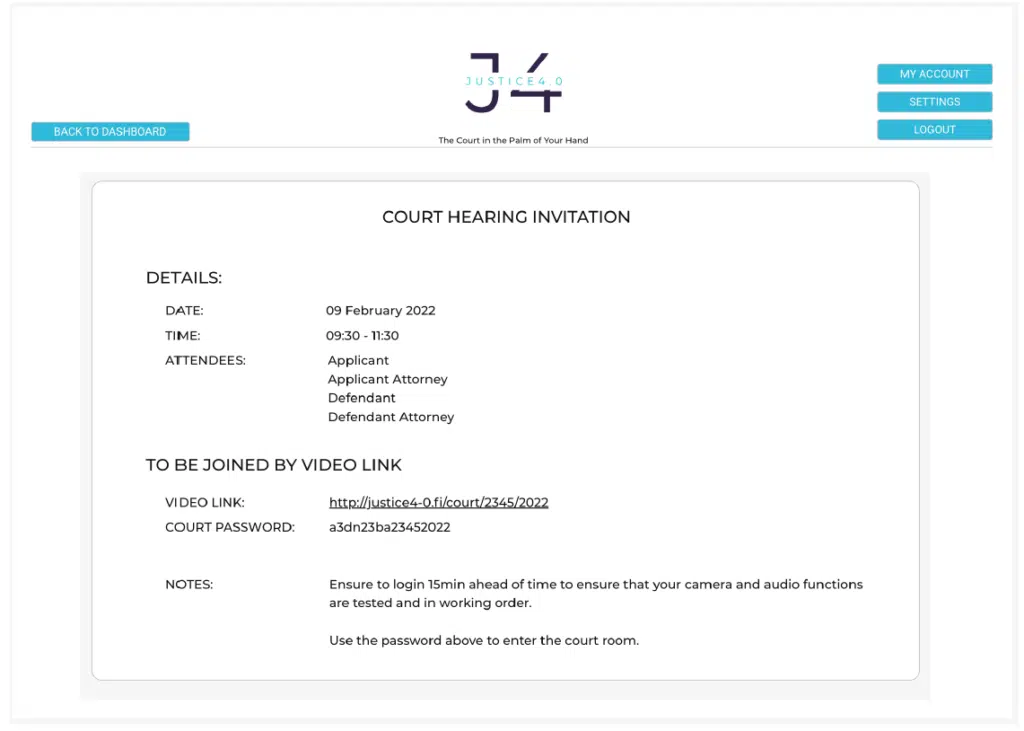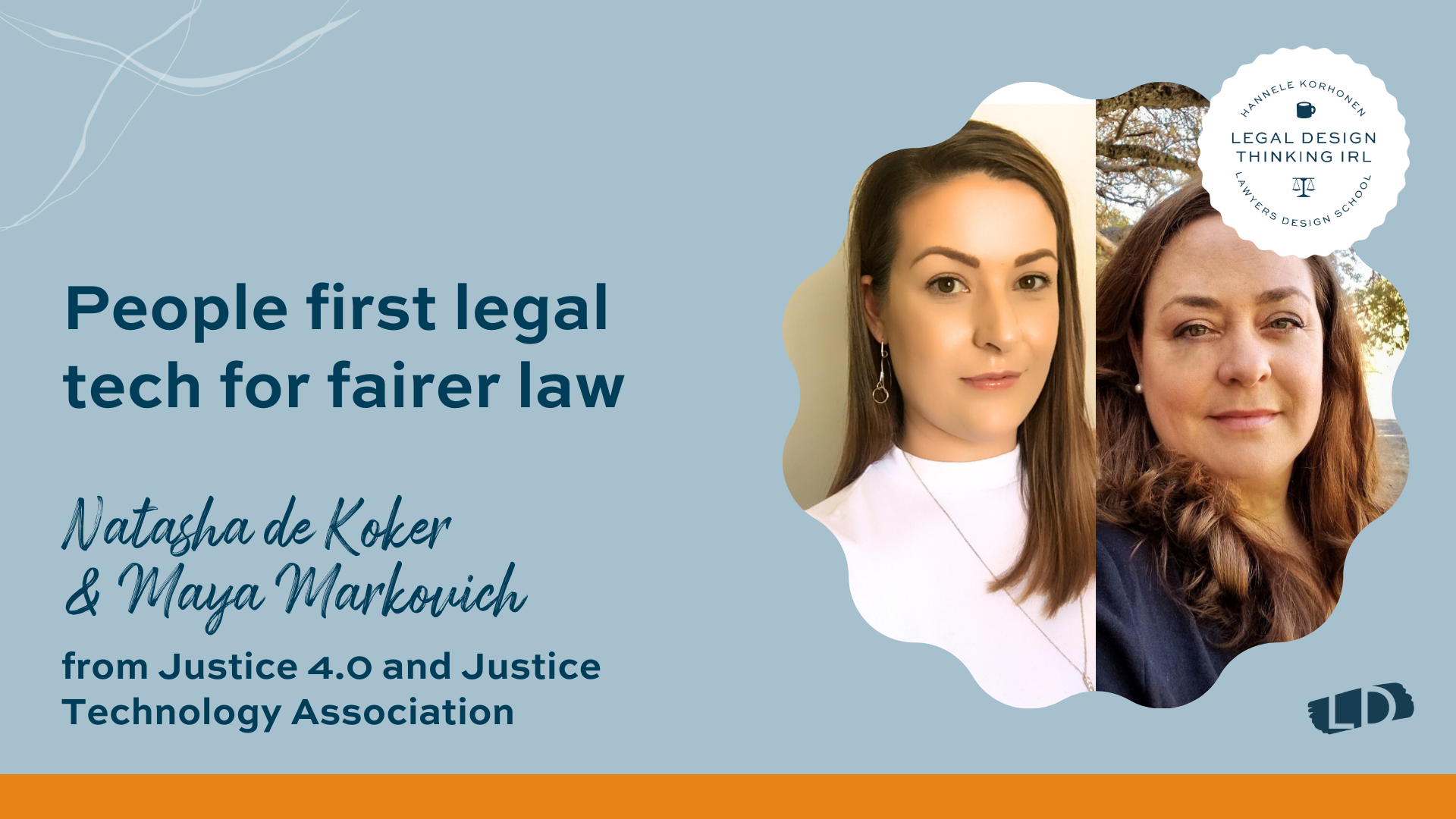Legal tech and user-centred design will create a fairer legal system
Creating legal tech for an inclusive and more accessible legal system without the input of the people it serves is pointless.
Fortunately, we have dedicated professionals committed to empowering everyday people by creating justice tech solutions that are built alongside the people who are going to use the tech through user-centred design so they actually serve the people they’re supposed to.
Today we’re talking about legal tech and user-centred design as well as taking a look at a real-life legal tech solution called JUSTICE4.0.
JUSTICE4.0 is a legal tech solution built for and with the people it’s designed to serve. Its goal is to make the law accessible, and less complicated and give everyday people access to courts in an inexpensive way, with the option of online hearings. Head to minute 36 of Legal Design IRL to see the live demo. It’s inspiring. This solution is still in the beta phase.
At the moment, the legal system is built to benefit the powerful stakeholders – the lawyers, the institution and big business. It excludes the majority of the community – the people who need access to the system. But this is changing.
This is the transcript of my discussion with Natasha de Koker & Maya Markovich in the series Legal Design IRL where we discuss the intersection of justice tech and user-centered design and get a practical example of how putting people first create tech solutions for a fairer legal system.
Introducing Natasha De Koker
Natasha De Koker is the Co-founder of JUSTICE4.0 has seen and experienced the hardships caused by the inefficiency of the traditional court processes. Coming from a third-world country and seeing similarities in Finland of an inefficient court process, and the added corruption has inspired her to make it her mission to change the way the court process is done, by providing a solution that is fair, transparent, and accountable.
Introducing Maya Markovich
Maya Markovich has a unique background spanning VC, law, behavioral science, and change design. Maya delivers technology, process, and business growth services worldwide. She has served as chief growth officer for Nextlaw Labs/Nextlaw Ventures at Dentons and is currently a justice tech executive in residence at Village Capital and executive director at the Justice Technology Association. She advises startups, investors, and venture funds and consults on innovation and transformation initiatives.
What does user centered design in the law mean for you?
Hannele: And how would you define it?
Maya: For the average person decoding the law is very challenging. For lawyers, it can also be very difficult to understand. I use Margaret Hagen’s definition from Stanford legal design lab that legal design is the application of human centered design, to the world of law, and all of the concentric circles that ripple out from it, to make legal services and systems more human centered, more usable, and more productive and satisfying. That can take a lot of forms. It can include things like incorporating plain language, intuitive technology, when applicable, graphical representations of information.
Natasha: I’m not a lawyer, but the law and how the system works have always fascinated me. We’ve seen the good and the bad and how people, especially the stakeholders, have an impact on how matters go through the system and how long it takes. And in particular, something very personal to me, went to court and I said: Enough is enough, things need to change because the justice system is not meant for the people.
It’s meant for the people who have the money and authority bodies of the industry. And that’s not fair. And that’s how we came about designing a solution that is made for the people and was made by the people. That’s why we are here today with project JUSTICE4.0.
Why is user-centred design important in legal tech and justice?
Maya: Justice tech solutions must be built alongside and with those who the solutions are meant to serve.
There is no intermediary, for the most part, with many justice tech companies, because many of them, although not all of them are B2C.
At the Justice Tech Association, our justice tech startup members agree to a code of ethics, which includes a really significant focus on the end user.
So things like driving innovation of accessible technology, helping people navigate legal matters, and meaningfully bettering their lives. empower them to feel as though they can do it on their own and don’t necessarily need to.
They’re perfectly capable of doing it with the right tools and the right kind of framework around them. Also, the code of ethics also includes, you know, prioritizing consumer interest and mitigating consumer harm in any and all of the businesses and solutions.
It’s important to design a product for and with end users.
And as Natasha said, in our previous conversations, design injustice happens in tech when you don’t design a product for and with the primary stakeholders.
And when you don’t, you end up with chaos. Which is to a greater or lesser extent, depending on what jurisdiction you’re talking about, where we are right now. It’s a system designed to serve powerful users, as Natasha said, the, you know, the lawyers, the courts and the administration.
And it excludes a vast majority of people even though it’s supposedly designed around them. So it’s too complex.
“And where we need to apply legal design and user centered design more broadly, is by designing with, and for these folks. And if we don’t do that, we’ll continue to basically have systems that continue with the status quo.”
And so the application of user design, user centered design, and legal design should be mitigating that. And with that kind of approach, it has a much greater success of rating, probability of success and scalability.
What concrete improvements have you seen in user-centred design in law
Maya: It’s probably not what you’re looking for, but the concrete learning that I’ve come away from all of this with is when user centered design is applied in its most elegant and fundamental form, to justice technology and to issues that arise from interacting with systems of justice – is no one knows that it exists. And no one knows that it was actually applied. It simply is an understandable process tool system.
JUSTICE4.0 – a concrete justice tech user-centred solution
Natasha: Our organisation became involved in an administrative dispute in Finland and our experience set us on a mission to make sure that every person out there has access to a court and a way to resolve their legal disputes.
If it’s by way of providing them with an online court, or if it’s connecting them to a lawyer who can help them or if it’s by way of giving them some kind of comfort in that the justice system is not against them, that it’s actually there for you.

What is JUSTICE4.0
JUSTICE4.0 is a digital tool or digital gateway, that runs parallel to the current justice system and provides those who prefer a digital way to access court services.
And for those who still want to go the traditional way, you still want to go to an actual building, you can still use the solution.
We’re not replacing the system, we are giving people who cannot always come to a court an opportunity to go to court. One of the big problems in Finland we see is people don’t pursue small claims in court because the fees are expensive. So there’s no incentive to litigate over the 700 Euro debt threshold to start an action.
So we are working towards providing the same service of opening a case, defending a case and attending a court hearing online, which is a cheaper option than actually going to court. The great thing about this is that Finland doesn’t have a small claim solution at the moment. Everything is run through the District Court.
So you have to wait a very long time to eventually get your case heard.
But we provide a small claims-specific solution that could only deal with small claims cases. You know, it really doesn’t matter what the size of your claim is. The fact is you want equal justice, you want your opportunity for someone to say: “You know what, you were right, that person does owe you the money, please pay the money.”
You know, that kind of satisfaction goes a long way. And the 100 Euros or 10,000 Euros, for each person, has a different meaning. And for some people, 100 Euros is a week’s food. And if you give up because the cost was so expensive, it makes you feel that your country or the government’s not taking care of you as a person.
You know, we have all these luxuries in Finland, like health care and social benefits. But what does all that mean when you cannot resolve a simple dispute like a small claims dispute easily and quickly?
That’s where we come from. And I think that the biggest problem we are trying to tackle at the moment is to get the people who just walk away to have an opportunity to get access to equal justice.
Hannele: Maya, what are your thoughts on JUSTICE4.0
Maya: When I first met Natasha and the team I recognized right away the challenges that are trying to be solved. They’re equally frustrating in almost every country. The wheels can turn very slowly. And for some people, that is not a problem. For some people, attorney’s that is an advantage. And for some people, that is a deal breaker and can really have an adverse effect on their lives, in very significant ways.
And as Natasha said, quite rightly, you know, the measurement of what is a significant impact, financially speaking, is different for every person. Right? This challenge, it’s very familiar to me,
Even with small claims, it’s still confusing, it’s still a matter of finding time to get off of work to go to this to go to court to figure out which forms to fill out and figured out how to form, fill them in correctly, and file them in triplicate, with the court clerk and then come back.
And all of these things are, they’re not designed for relief. They’re not focused on that. They’re focused on just a process that has grown organically without any thought, or much thought, at least, not speaking for Finland, specifically, but in general, you know, not, that has grown without much thought of the impact and the user experience. And the user journey.
And that’s why I think that this is such interesting and important work to be mapping out the existing journey and finding the points at which you can really apply legal design to almost immediate positive effect. There’s so much opportunity to improve these things anywhere from some very small changes in digitizing court files, for example, all the way to an entirely new, separate kind of branch of the judicial system.
All of those things are open for opportunity and Finland is a great place to incubate these types of big moves, because there’s the will, there’s an understanding of the need, and there’s the ability to focus on a relatively small pool and get it right. And then from there, see what else can be done.

The user-centred approach in JUSTICE4.0
Hannele: Natasha can you tell us how you approached the design using the people-first approach?
Natasha: When we did our customer interviews, we found that traveling to court was one of the major problems. People had to take time off work, change plans or delay holidays.
And then we had a lady who explained that when she has these small amounts that she needs to dispute, she has to always get a third party to help her because she doesn’t have the time, she doesn’t have the knowledge.
And then the other issue that also came up was people don’t understand the information that’s provided, they don’t know where to find the know-how or their rights. They don’t know how to start, because remember, when we started researching the administrative court, and how everything works, we were given so little information online.
And when you use Google Translate and translate from Finnish to English, it’s not always accurate so it becomes misleading when you use Google to translate documents, and you speak to your Finnish lawyer, and she’s like, but that is not what it’s saying. So language is a problem too.
And then the one thing that came up that we never thought about, was privacy. People feel very uncomfortable when they sit in a courtroom, and then random people from the public enter the courtroom, and they sit in the gallery and watch this case unfold. And it’s none of their business. And they felt that even though that is very uncomfortable, and they wish that they would do more of a closed court, then, but unfortunately, justice is a public space. And you know, people can come and go, and unfortunately, that is what it is.
The user went on to explain that it’s her life, her matter and her privacy. She doesn’t want the world to know because tomorrow they might bump into that person and feel like they need to explain. Plus, when you’re taking time off to go to court, you need to explain to your boss.
It’s kind of like a stigma people get in Finland. When they go to court, it’s quite heavy on them. Because when you say I’m going to court for a legal dispute, people kind of label you as guilty. And it doesn’t matter which side you’re on. If you’re the applicant, or the defendant or witness or, you’re guilty until the judge finally says you’re not or thank you for your participation. I don’t think that people, in general, are very much open-minded, that when you go to court, you’re actually going to get justice, you’re going to get relief. And it’s kind of like a being to be ashamed to access something that’s given to you as your constitutional right.
So these were kind of the stories that came up and they were very saddening because I feel that people are ashamed of having access to something that’s given to you that’s supposed to help you resolve a dispute that’s causing hardships in your life and it’s causing hardship such as psychological stress.
And, you can lose your job because you can’t perform because you’re stressing, you’re taking time off and there’s frustration out in your family. It’s ripping people apart. It’s breaking you as a person because you’re ashamed because you don’t want to because you feel that it cannot help you.
That is what comes from these interviews. We would really love to learn more about people’s experiences and listen to their stories, because as we get more stories, and we learn more about people, we will start seeing that there’s a lot of similarities. And the similarities are the things that we need to focus on immediately to try and relieve or resolve or improve.
Seeing the similarities gives us the first step so that we can take the next step. Because what we are seeing is the justice system is failing the system. So let’s flip it around. Let’s try a new solution.
But the first step was identifying that the system is complicated
Natasha: So the main thing the user interviews showed is the system is complicated, so it was important the solution was user-friendly for everyone, regardless of education level or experience with the legal system. And including plain language information so the users can understand the process. And have an online court system where your hearing is held online and recorded and stored in your app.
Then we designed a web application so that anyone can access it – the library, phone or home PC.
We want to provide a solution that offers value and a reason to go to court to get the money someone owes me.
JUSTICE4.0 live demo
Head to minute 35 for the JUSTICE4.0 live demonstration.
The next step will be to take it to the users and get feedback and continue to improve the app. This is an iterative process. If you want to be part of the user testing, please contact Natasha.
Where can we find you
Maya Linkedin
Natasha LinkedIn
Legal design thinking: IRL. Episode 36
You’ve just read a summary of my LinkedIn Live with Natasha de Koker & Maya Markovich
I’m sure you’ll agree the JUSTICE4.0 initiative is a fantastic example of making the law more accessible. You can watch the demo at minute 36 of the video. If you want to be part of the user testing, please get in touch with Natasha.
Maya has enormous experience in design and innovation – and welcomes contact on LinkedIn too.
Each week I provide actionable advice for law firm owners and discuss real-life legal design in action.
You can catch a replay of episode 36 Legal Design Thinking: IRL or join me live and ask questions.
Want to chat about it?
Follow me at @lawyersdesignschool for more tips and tools.
Prefer email? Drop me an email at [email protected]. And while you’re here, take a peek at the Lawyers Design School and check out other ways to use legal design thinking to grow your law firm and thrive in your business.
Watch all the Legal Design IRL Episodes episodes.
Grab a virtual coffee with me and let’s figure out the next step!


